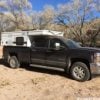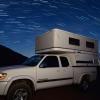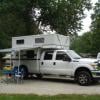
DIY Solar/Trimetric/6 Volts on a 2015 Grandby
#31

Posted 07 February 2016 - 04:24 PM
I am haunted by waters
#32

Posted 07 February 2016 - 04:34 PM
My question still is:
Does FWC installation with solar or without provide for charging of camper batteries from the truck alternator? Factory not after purchase.
Not can it be wired to provide this, but does FWC wire the camper and truck connection to provide the charging of the batteries via the truck alternator?
Thanks,
Phil
Yes, supposedly, but I was told directly by FWC (someone who is no longer there) that it is not enough to make a real difference and not something you can count on... I tried to dig into this but it seemed I was given "gut feeling" info, rather than engineering data which I expect they would have. "if you have xx truck or alternator, expect xx amps".
At the time I purchased my FWC, and they did the install, I was not informed enough to really understand the issue and how important it was. In another thread where someone was asking what to do at the time of purchase /install, I suggested they have FWC show/prove that the batteries are being charged and everything is wired correctly. It is critically important.
Edited by DonC, 07 February 2016 - 04:35 PM.
#33

Posted 07 February 2016 - 05:07 PM
This is a long story but there is good information had here charging batteries with different inputs.
http://roadslesstrav...er-shore-power/
And one from the Expo portal
http://www.expeditio...-simultaneously
Excellent links pvstoy! I have wanted an in depth explanation of how solar and alternator charging affected each other and now I know that and a whole bunch more!
2018 Ford F-250. Customized Bundutec Sable ![]()
#34

Posted 07 February 2016 - 05:26 PM
Before my ATC camper I had a Palomino pop up camper. The Palomino connected the truck battery to the camper battery in parallel through a 40 amp circuit breaker. The ATC adds a APOC R12140B dual sensitive isolator located in the battery compartment. I had problems with the camper battery discharging, so I bought a cheep cigarette lighter type plug-in voltmeter for the 12V camper socket. You can use it to measure the truck battery voltage with the truck key on so the 12 V plug is connected.
1) Truck off both voltmeters should read the same between 12V and 12.8V.
If not you have a truck to camper connection problem.
a) check wire connections, plugs and fuses.
![]() if only one of the batteries are low the battery isolator may be switched off
if only one of the batteries are low the battery isolator may be switched off
if starting truck doesn't fix you need to trickle charge the low battery
2) Truck on both voltages read between 13 and 14.5 V
a) if truck battery is low you have an alternator regulator problem
![]() if camper voltage increases but is low there is a connection problem
if camper voltage increases but is low there is a connection problem
c) if camper voltage dose not increase its probably the isolator
When I met with Marty at ATC to get my camper he said that if the camper battery voltage drops below (some level 11V?) the battery isolator will not connect to the truck battery and you will have trickle charge the battery. I haven’t had this problem but I have noticed with the 3-way fridge on 12 V and the truck idling, I can hear the isolator switching on and off every second or two.
Otherwise there is a connection problem (check both white wires and black wire connections) or blown fuse probably located next to the truck and/or camper batteries. In my Palomino I found there was an additional inline fuse hidden under the sink that connect to the truck battery but thats another story. If while running the truck the truck battery voltage is 0.5 V or more than the camper battery, there is connection problem between the truck and camper.
Adding solar should not change the connections of the truck and camper batteries, they are still wired in parallel with a fuse or two and the battery isolator. The only difference depends on the solar controller. For some controllers the camper load distribution for the lights, fridge, heater ... is connected directly to the camper battery or for some it is connected to a load connection on the controller. Either way the connection described above should work the same.
There are some exceptions the D250S Dual solar controller isolates the truck camper batteries. I got this feedback from the manufacturer.
"The D250S DUAL will take power where it is easiest to find. If the engine is running it is from the alternator, even if the solar panels are producing a bit.
When the engine is turned off the power will come from the solar panels. If the voltage is below 13,1V the D250S DUAL will not start.
If you have a D250S DUAL connected between the starter battery and the service battery, there will be at the most 20A flowing between the batteries, if the batteries or the charger for some reason should be short cutted there is a built in barrier that will prevent a too big energy flow.
As an extra insurance you could mount a fuse near the positive pole on the batteries."
I am in the process of changing out the fuses with circuit breakers that are in line with batteries. The circuit breakers automatically reset, so if for some odd reason something inadvertently shorts one of the battery connections it will reset and you won't wake up some morning with a battery problem.
Edited by carld, 07 February 2016 - 05:38 PM.
2002 Tundra AC 4x4 with 2015 Ocelot
2006 Tundra AC 4x4 with 2018 78" Ocelot
2011 Tundra AC 4x4 with 2010 78" Ocelot
#35

Posted 07 February 2016 - 05:44 PM
Read the Expo posts listed in the thread site given above...very informative but with this limiter; not knowing exactly what FWC has installed in the camper as delivered, nothing definitive can be ascertained. Something that resonated with me in one of the posts was that FWC is "terrible" at disseminating information and specifics about what is installed in the current camper models.
I am "In a penny, in a pound" and do not question my decision to buy a Hawk; even sight unseen yet. But all along I have tried to glean the details of what components are going into the Hawk as delivered to us on 2-25. No luck. I understand running changes, but the FWC website should be updated and more detailed in my estimation. A buyer should know exactly what components are in the product they are laying the bucks down for.
I love discovery learning and will ferret out how it all comes together in our Hawk. But the less time dicking around and the more time using the camper would be a plus... ![]() .
.
Yet again, can't thank all the folks on this forum enough for their excellent McGyver ideas and details on the FWC campers.
Thanks!
Phil
#36

Posted 07 February 2016 - 06:07 PM
It wasn't until I left the campground and was in full sun at noon, that the solar panel charged the battery enough to allow the truck to begin charging the camper batteries. By the time I got home, the solar and truck had significantly recharged the camper. To finish restoring the batteries, I plugged into AC and let the Iota take the state of charge to full and enter float stage.
I'm sure that I reduced battery life in that one trip. Now, I monitor the voltage on the Zamp controller and run the truck for a while to boost battery charge if it drops too low. I also bought a 100 watt panel that can be tilted & placed in full sun early & late to take advantage of available sun. Live and learn.
Paul
#37

Posted 07 February 2016 - 06:43 PM
"Before I realized it, my battery voltage was below that required to enable charging by the truck through the isolator"
"..run the truck for a while to boost battery charge if it drops too low".
What exactly are these voltage threshold amounts referenced above?
Year of truck and camper?
Thanks,
Paul
#38

Posted 07 February 2016 - 06:47 PM
Sent from my SM-G900V using Wander The West mobile app
#39

Posted 07 February 2016 - 07:45 PM
"Before I realized it, my battery voltage was below that required to enable charging by the truck through the isolator"
"..run the truck for a while to boost battery charge if it drops too low".
What exactly are these voltage threshold amounts referenced above?
Year of truck and camper?
Sure Power battery separator data sheet
2010 Tundra, 2014 Hawk with factory two battery auxiliary system and factory Zamp solar 100 watt solar and 15 amp controller.
Portable Renogy 100 watt bendable panel (yes, mine is still working)
Note the recommended battery cable sizes in the data sheet. FWC uses 10 gauge that runs approximately 20 feet counting the down to the frame and up to the camper and jogs. This results in a larger voltage drop than ideal depending on current flow.
Unless I am misunderstanding the data sheet, if the camper battery drops below 12.4 volts, the separator will not connect the camper battery to the truck charging system. You will need to use solar, connect to AC mains, or use a separate battery charger to get the camper batteries above 12.4 volts for the truck charging system to charge your batteries. The truck charging system must provide at least 13.2v at the battery separator to connect the truck charging system to the camper batteries.
When my camper battery was too discharged, I could hear the separator click on after starting the truck then click off after a delay of a few seconds as I was trouble shooting the issue. I did not have many tools and did not have the data sheet with me at the time.
Paul
#40

Posted 07 February 2016 - 08:53 PM
Besides mentioning that it can be pretty cold and noisy back there I did learn a few things. I did this with the solar system unplugged so that only the truck charging could be evaluated.
1 - it took several minutes of running the truck before I got any power at all as seen on the trimetric. The truck voltage would have to get up to at least 14+ volts before I noticed anything. I could see inside the cab and the trucks volt meter while we drove.
2- there is certainly voltage loss in the stock system. I have a Chevy 3500 Duramax and the voltage was less than I could see in the truck. When I've measured it before with my volt meter not while driving I've noticed a 0.1-0.3 voltage drop between camper and truck.
3- if your camper voltage is 12.4 or below you may not get any charging from the truck at all. The isolator won't make the connection between camper and truck batteries.
4- if your voltage is high enough in the camper and if your truck alternator is putting out enough voltage you can get decent battery charging. It would take a very long drive to full charge a system from 50% to full.
Most people wouldn't routinely drive 8 hrs or more to make it charge completely. It would be like putting out a solar panel and expecting it to completely charge your system in 2-3 hours. Just isn't going to happen.
5- the truck charging is best if you are in the "bulk" charging state. It makes up the most difference then. You'd have to drive forever to get to 100% once you are in the float stage of charging.
I suspect that most of these issues are due to differences in truck alternators, isolator issues or how FWC wired the campers.
Personally they have wired 2 different trucks for me and both worked great.
2015 Silverado Crew Cab Duramax and 2015 Front Dinette Grandby
One can change the world, it only requires kindness
http://www.truckcamp...g-family-earth/
0 user(s) are reading this topic
0 members, 0 guests, 0 anonymous users


















